Czichos H., Saito T., Smith L.E. (Eds.) Handbook of Metrology and Testing
Подождите немного. Документ загружается.


848 Part D Materials Performance Testing
15.1.2 Environmental Impact
on Polymeric Materials
Relevant Environmental Factors
In chemistry, a differentiation is usually made between
inorganic and organic matter. This discrimination is not
an arbitrary one but rather reflects the completely dif-
ferent nature of the two. While the corrosion of metals
as the economically most important environmental im-
pact on inorganic matter has already been dealt with
in Chap. 12, this subsection will look exclusively at
polymeric materials. The latter not only present the
most important sector of organic material but also ex-
hibit an abundant variety of reactions and in general
complex reaction behavior.
For (technical) polymeric materials, some special
environmental factors are of basic relevance. Bond
energies of a few eV (the solar UV comprises the
range 3.1–4.1 eV) make them sensitive to UV radia-
tion, which makes weathering resistance a basic topic
for polymers. Other relevant environmental factors will
be only shortly discussed here.
Ageing – all the irreversible physical and chem-
ical processes that happen in a material during its
service life – often limits the serviceable lifetime to
only a few years or even months. Thermodynami-
cally, ageing is an inevitable process, however its rate
ranges widely as a result of the different kinetics of the
single reaction steps involved. Ageing becomes notice-
able through changes of different properties, varying
from from slight loss in appearance properties to total
mechanical–technical failure. Ageing is mostly asso-
ciated with a worsening of material properties, but
sometimes it can also result in an improvement of prop-
erties, e.g. UV hardening.
Relevant environmental factors for the ageing of
polymers are
1. solar radiation (see weathering exposure in the fol-
lowing),
2. heat,
3. chemical environment,
4. mechanical stress,
5. ionizing radiation,
6. biological attack.
Heat. Because of their low bond energies technical
polymers can only be used in a limited temperature
range [15.15]. Polyvinylchloride (PVC) for instance is
only suited for permanent use up to 70
◦
C, polycarbon-
ate (PC)upto115
◦
C.
Thermal properties in general are dealt with in
Chap. 8.
Chemical Environment. Exposed to water some poly-
mers, like polyamides (PA), polyester, polyurethane,
can be hydrolized, the mechanism for which may
depend on acidity. Other polymers show a high sen-
sitivity to atmospheric pollution, e.g. polyamides and
polyurethanes even at room temperature are attacked by
SO
2
and NO
2
.
Akahori [15.16] used exposure to neutral oxygen
radicals, produced by a plasma generator, for acceler-
ated ageing tests.
Mechanical Stress. In the case of mechanical expo-
sure, free radicals can be formed by rupturing chemical
bonds, which is used as the initiation step in stress
chemiluminescence [15.17].
Ultrasonic degradation can be used to produce poly-
mers with a definite molecular size [15.18] or to degrade
polymeric waste products. Frequent freezing/thawing
cycles may also lead to degradation of dissolved poly-
mers.
Ionizing Radiation. The impact of high-energy radia-
tion (γ -, x-ray) leads to degradation and/or crosslink-
ing [15.19]. In the presence of oxygen, degradation
predominates.
Biological Attack. Not counting the mainly mechanical
attacks of rodents or termites, microorganisms – such as
mildew, algae and bacteria, that colonize their surfaces –
can damage polymeric materials. Damage mechanisms
varyfor different polymers [15.20]. The microorganisms
may attack in a direct way by breaking chemical bonds,
or can act indirectly, e.g. increasing the migration of
stabilizers. Producing their own pigments they can also
disturb the appearance of the surfaces by color change.
In contrast with protecting polymeric materials from
biological attacks (biocides) the opposite strategy is fol-
lowed in sensitizing polymers to biodegradation for re-
cycling.
Chapter 14 deals with the biogenic impact on mater-
ials in general.
Often the combined action of these environmental
factors, which occur as synergistic or antagonistic ef-
fects, has to be considered.
Weathering Exposure
Ageing of polymeric materials by the impact of
weathering is mainly initiated by the action of so-
Part D 15.1
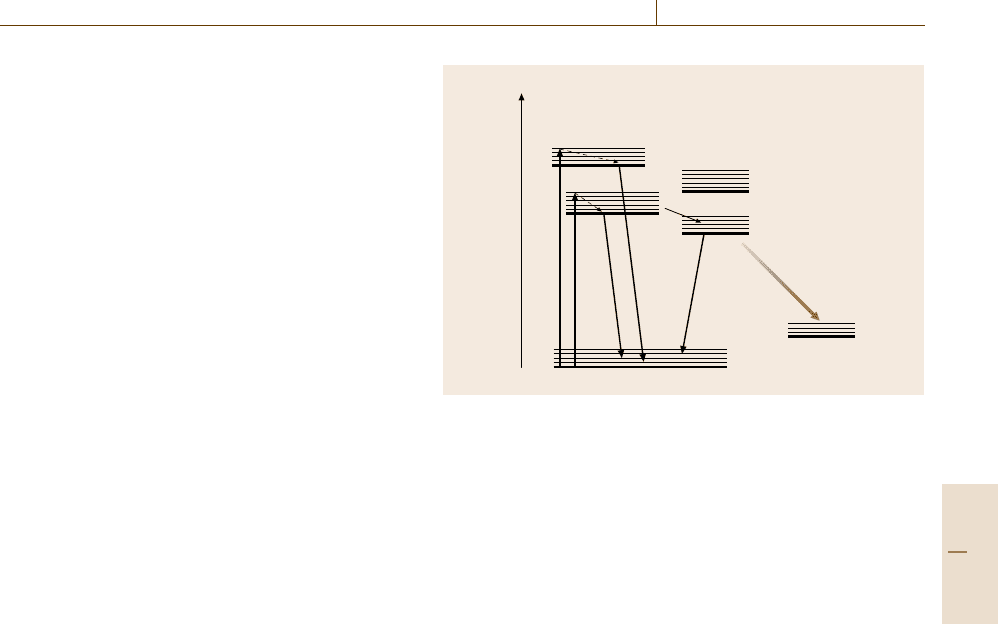
Material–Environment Interactions 15.1 Materials and the Environment 849
lar radiation. However, other climatic quantities such
as heat, moisture, wetting and ingredients of the at-
mosphere, influence the photochemical ageing and are
answerable for the final ageing results. To date there
are no satisfactory general answers to the questions
of the accurate mechanisms of the photooxidation and
photodegradation of pure polymers, not to mention
technical polymeric materials.
General Principles of Photoinitiated Ageing. From
a theoretical point of view, pure aliphatic polymers
show no absorption in the spectrum of solar radia-
tion. For example, the UV absorption bands of pure
polyethylene, which contains only C
−
CandC
−
H
bonds, are located at wavelengths below 200 nm. Only
polymers with aromatic groups or conjugated double
bonds absorb natural solar UV radiation. For this rea-
son, many polymers should be capable of withstanding
the action of solar radiation during outdoor exposure.
The spectral response of a property change of
a polymer in the solid phase does not coincide with
its absorption spectrum in the spectral range of solar
radiation. Even in many aromatic-type polymers, the
absorption of radiation, which is responsible for the
initiation of ageing, takes place through chemical irreg-
ularities or impurities. These originate either during the
polymerization process and the processing of the poly-
mers or are residues of catalysts. These chromophores,
which are capable of absorbing the UV portion of ter-
restrial solar radiation, are unavoidable in technical
polymers. Menzel and Schlüter [15.21] for example de-
scribe an increase of absorption at wavelengths above
300 nm and a decrease of weathering resistance after
multiple processing of PVC.
Photoinitiated ageing of polymeric materials can be
caused
1. directly via an excitation of a molecule in a non-
binding state that leads to photolytic chain scission
(dissociation);
2. indirectly via an excitation of a molecule in a bound
singlet state S
x
that can be deactivated by several re-
action paths, e.g. an oxidative reaction of the exited
polymer molecule with O
2
.
The multistage processes of photoageing can be il-
lustrated by the rough scheme in Fig. 15.5,whichshows
the levels of the exited states of an organic molecule A.
The levels S
1
and S
2
(singlet states) and T
1
and T
2
(triplet states) are the most important energy levels in
photochemistry. The thin lines above these levels indi-
cate the vibrational and rotational levels. The nearly ver-
Energy
Degradation
A
B
a
f
p
S
2
S
1
S
0
T
1
T
2
S
0
Fig. 15.5 Scheme of the energy levels and transfers in an organic
molecule, a – absorption, f – fluorescence, p – phosphorescence and
photochemical degradation
tical solid arrows indicate the absorption and emission
of radiation, the dashed arrows show radiationless en-
ergy transfers. The main processes are described below.
1. Absorption of radiation is the initiating photophys-
ical reaction. At room temperature the polymer
molecule A is in the ground state S
0
. By the absorp-
tion of a photon, it is transferred from the ground
state S
0
to the exited state S
1
(including vibrational
and rotational levels) and, at a higher photon en-
ergy, also to the exited state S
2
. Under conditions of
natural and artificial weathering, the absorption of
radiation can be considered as largely independent
of any external influences.
2. This is followed by deactivation of exited states. The
electronically exited states are no longer in a ther-
mal equilibrium and try to transfer the absorbed
energy within a very short time. This deactivation
takes place by several competing processes:
a) Intramolecular deactivation. This energy trans-
fer takes place from the exited state S
1
by
fluorescence, or after internal conversion, in-
tersystem crossing and relaxation from higher
vibrational energy levels from the exited state
T
1
by phosphorescence. This type of deactiva-
tion does not change the polymer molecule.
Therefore, the absorption of radiation is not
a sufficient condition for an ageing process.
Even if the absorbed energy is high enough to
rupture a bond, the energy has to be accumulated
in this bond.
Part D 15.1
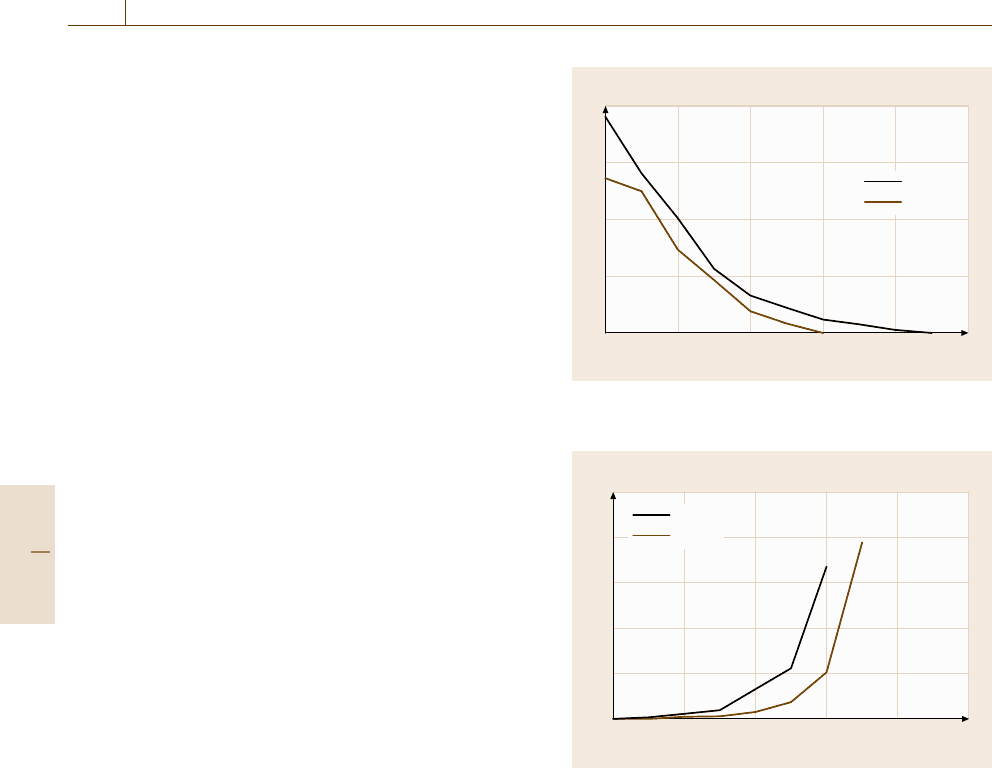
850 Part D Materials Performance Testing
b) Intermolecular deactivation. This also takes
place from the exited states S
1
and T
1
by radia-
tive and radiationless transitions to an acceptor.
This energy transfer plays an important role in
photostabilization and even the photosensitiza-
tion of polymers.
c) Deactivation by chemical reactions. In a non-
binding electronically exited state, the weakest
of the bonds involved dissociates into two rad-
icals. These reactive intermediate pieces can
recombine or react with many other molecules
to form stable final products.
For a comprehensive survey of the photochemistry
of polymers see, e.g., Calvert and Pitts [15.22]orRanby
and Rabek [15.23].
This short and superficial representation of the com-
plex reaction processes during photochemical ageing
gives an idea of the numerous factors that can influence
photoinitiated ageing at many stages. These influences
on the ageing behavior of polymers can only be roughly
predicted by means of theoretical considerations. Quan-
titative results on the influence of the different climatic
quantities have to be determined by experiments.
To interpret the results from artificial weathering
tests, it is necessary to have an idea of the influences
of the different climatic quantities on photochemical
ageing. This paper summarizes some results of inves-
tigations on the spectral response of polymers and on
the influence of heat, moisture, the style of wetting, acid
precipitation and biofilms on ageing results.
Spectral Response of Polymers. The spectral response
of polymers is usually expressed in terms of their
spectral sensitivity or activation spectrum, which un-
fortunately are not used consistently in literature. Data
on the spectral response of polymers can be obtained in
principle by two methods
1. A direct method, where the effect of a wave-
length of radiation is determined by irradiation with
a small spectral band or line of radiation with
known irradiance. This technique determines the
spectral sensitivity (or wavelength sensitivity), see
Trubiroha [15.24,25].
2. An indirect method, which ascribes the incremental
property change measured behind a pair of filters to
the incremental (UV) radiation of a radiation source
transmitted by the shorter-wavelength filter of the
pair. This technique, the so-called filter technique, is
used to determine the activation spectrum of a poly-
mer, described in full, e.g., by Searle [15.26].
30
20
10
0
40
280 300 320 340 360 380
λ (nm)
ΔM
V
(%)
1 MJ/m
2
PA 6
PA 66
Fig. 15.6 Spectral sensitivity of polyamides, change in
molar mass M
v
as a function of wavelength of irradiation
250
200
150
100
50
0
280 300 320 340 360 380
10 °C
50 °C
H
e
(kJ/m
2
)
λ (nm)
Fig. 15.7 Spectral sensitivity of polycarbonate at 10 and
50
◦
C. The graph shows the radiant exposure H
e
, neces-
sary to produce a 10% loss in internal transmittance as
a function of the wavelength of irradiation
Spectral Sensitivity (or Wavelength Sensitivity). Spec-
tral sensitivity data can be obtained by
1. observing the changes of a polymer property as
a function of an equal radiant exposure with nearly
monochromatic radiation at different wavelengths,
2. observing the radiant exposure with nearly mo-
nochromatic radiation, necessary to produce a de-
fined change of the polymer property, if the change
of the property is not linearly dependent on the ra-
diant exposure.
The spectral sensitivity of the decrease of molar
mass of additive-free polyamide films with a thick-
ness of about 40 μm is illustrated in Fig. 15.6. The
Part D 15.1
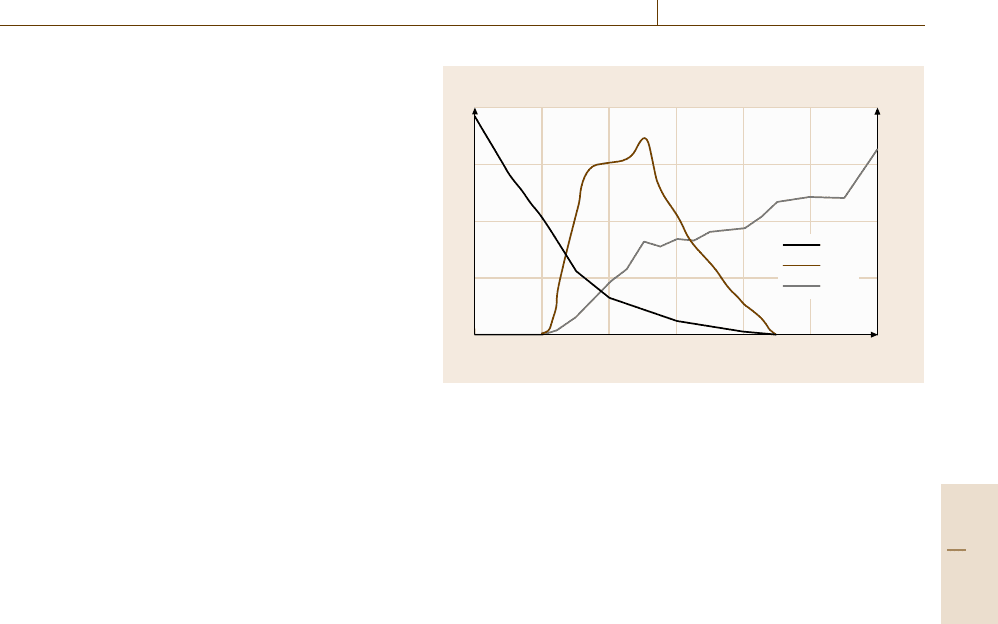
Material–Environment Interactions 15.1 Materials and the Environment 851
changes were normalized for an equal radiant exposure
of 1 MJ/m
2
at each wavelength in the spectral range
280–380 nm. The figure shows the decrease of the mo-
lar mass M
v
of the two polyamides PA 6andPA 66
with wavelength of irradiation. The change of M
v
was
linearly dependent on the radiant exposure in the inves-
tigated range.
PA 6 was more sensitive than this PA 66. The sensi-
tivity of molecular degradation increases strongly with
decreasing wavelength. Molecular degradation of the
PA 6 film was only sensitive to wavelengths shorter than
370 nm. The PA 66 film only degraded at wavelengths
below 340 nm.
The spectral sensitivity of the yellowing of a PC film
with a thickness of 0.7 mm specimen temperatures of 10
and 50
◦
C is shown in Fig. 15.7. Because the yellowing
of PC is not linearly dependent on the radiant expo-
sure the figure shows the radiant exposure H
e
which
is necessary to reduce the internal transmittance of the
PC film at 360 nm by 10%. With increasing wavelength
higher radiant exposures are required to produce this
defined change of internal transmittance. With increas-
ing temperature the curve shifts to longer wavelengths
by about 10 nm, when the temperature rises from 10
to 50
◦
C, which means that the spectral sensitivity in-
creases with increasing temperature.
Activation Spectrum. The activation spectrum is the
polymer spectral response data measured using the filter
technique and is specific to a defined type of radiation
source and a fixed exposure time.
An example of the calculated activation spectrum
(AS)ofthePA 6 film with a thickness of 40 μmmen-
tioned above to solar global radiation E
glob
and the
spectral sensitivity (SS)aregiveninFig.15.8. A sim-
plified qualitative definition of an activation spectrum
is the superimposition of the spectral sensitivity (SS)
of a property change of a test specimen onto the spec-
tral irradiance E
eλ
of a given radiation source. At short
wavelengths the activation spectrum must be zero where
the spectral irradiance of the radiation source is zero;
at long wavelengths the activation spectrum must be
zero where the spectral sensitivity is zero. Therefore,
information on an activation spectrum needs to be ac-
companied by information on the spectral irradiance of
the radiation source.
Many other unstabilized and stabilized polymers
show no remarkable response to radiation of wave-
lengths above 400 nm [15.24, 26]. However, investi-
gations of very light-sensitive papers by the National
Institute for Standards and Technology (NIST) [15.27]
280 300 320 340 360 380 400
λ (nm)
ΔM
V
(%)
40
30
20
10
0
1600
1200
800
400
0
SS
AS
E
glob
E
eλ
(mW/m
2
nm)
Fig. 15.8 Polyamide 6 film: spectral sensitivity (SS) and activation
spectrum (AS) at solar global radiation E
glob
and of TiO
2
-pigmented polymers and paints by Kämpf
and Papenroth [15.28] ascertained a slight response
to wavelengths up to about 450 nm. Only very light-
sensitive color pigments fade strongly on exposure to
visible radiation.
These experimental determinations of the spectral
response of polymers have to be considered as typical
results that can be influenced for example by the tem-
perature, the degree of crystallinity and the thickness of
the specimen or the duration of exposure, not to mention
additives and pigments, which can be photostabilizers
or photosensitizers, see Trubiroha et al. [15.29].
Irradiance Level. Besides the wavelength, the irradiance
level during exposure may also have an influence on the
degradation behavior of transparent test specimens.
Figure 15.9a shows the decrease of radiant flux
in a clear transparent film for three different values
of the product μd (absorption coefficient × thickness
of a film/sheet) in relative units. If the photochemi-
cal ageing only depended on the absorbed energy, the
ageing results (Fig. 15.9b) would run parallel to the
curves of radiant flux in the film, calculated according to
E = E
0
10
−μd
.
Figure 15.9b illustrates schematically the changes
of carbonyl concentration in a low-density polyethylene
(PE-LD) sheet with a thickness of 3 mm as a function of
depth at different partial pressures of oxygen, measured
by Furneaux et al. [15.30]. In a pure oxygen atmosphere,
the change of the carbonyl index (infrared (IR) absorp-
tion region of the oxidation products) runs parallel to the
decrease of radiant flux. However, the radiation exposure
in air shows a strong formation of carbonyl groups at the
Part D 15.1
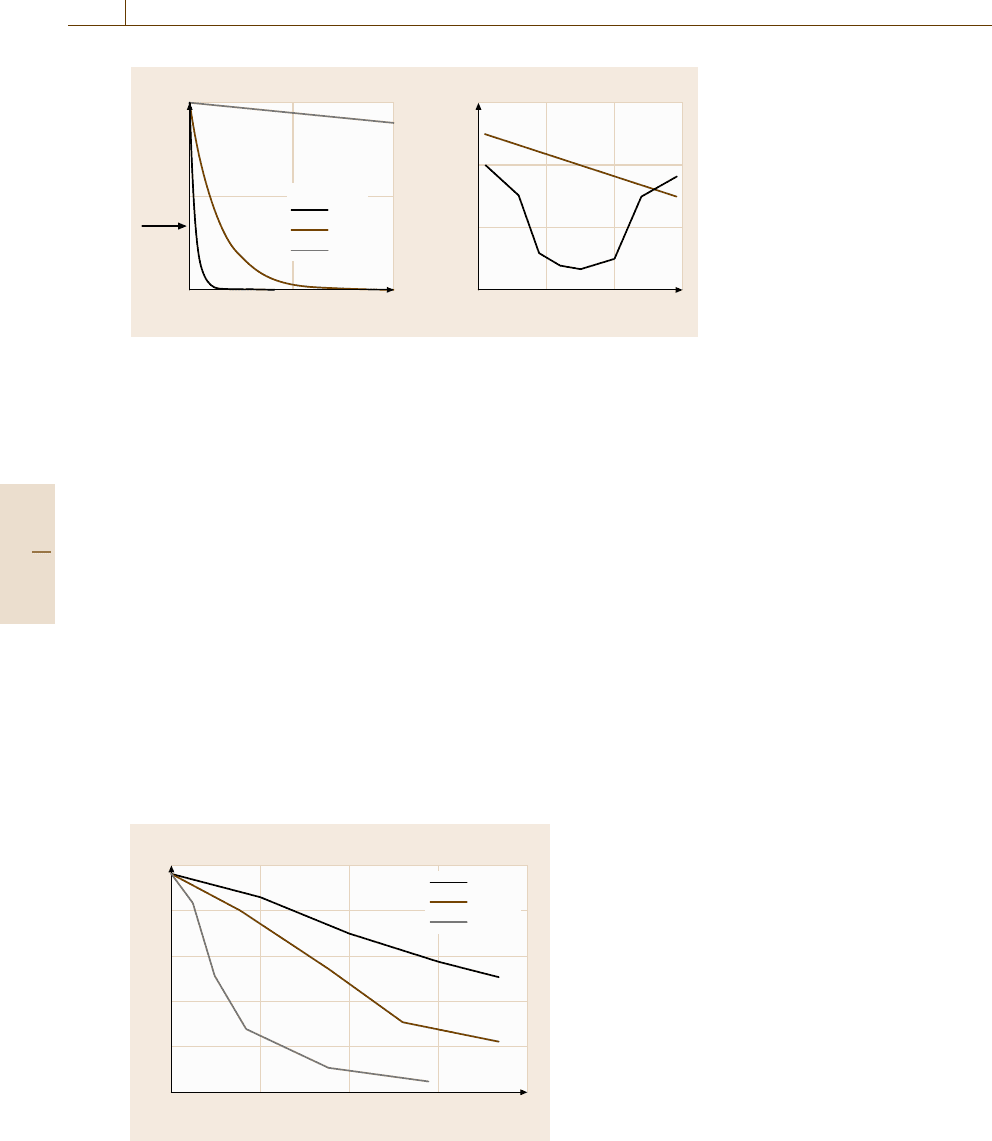
852 Part D Materials Performance Testing
Relative specimen thickness d (%) Specimen thickness d (mm)
0 50 100
0123
100
50
0
E (%)
0.3
0.2
0.1
0
In air
(N
2
+O
2
)
In O
2
PP
Cl
E
0
E=E
0
10
–µd
µd =
16
3
0.05
E
d
Fig. 15.9 (a) Radiant flux in a trans-
parent sheet, (b) change of carbonyl
index (CI) in a low-density polyeth-
ylene sheet with depth and partial
pressure of oxygen
two surfaces of the sheet. In the specimen’s core thick-
ness of 1 mm only very low carbonyl concentrations
could be found. The rate of photooxidation definitely de-
pends on oxygen diffusion, and thereby on the irradiance
level, which implies an indirect dependence on the spec-
imen temperature.
Photodegradation: Influence of Heat. Increased
temperatures do not only increase diffusion rates but
generally most chemical reactions. Figure 15.10 shows
the loss of gloss of a white TiO
2
-rutile-pigmented paint
with a binder system consisting of linseed oil/alkyd as
a function of the temperature of the specimen surface. It
shows the decrease of the reflectometer value at 20, 35,
and 50
◦
C, with time of weathering exposure. With in-
creasing temperature, there is an increasing loss of gloss.
The strong dependence of many photodegradation
reactions on the specimen temperature explains why it
was not successful to establish a weathering station high
100
80
60
40
20
0
0 100 200 300 400
20 °C
35 °C
50 °C
t (h)
R
60
(%)
Fig. 15.10 Loss of 60
◦
gloss of a paint with exposure dura-
tion t and specimen temperature
in the Alps, although there is a higher level of UV radia-
tion. The mean temperature was about 20
◦
C lower than
in weathering stations at sea level. Even Boysen’s at-
tempts to combine the natural weathering under daylight
with artificial UV exposure during the night did not show
the estimated acceleration due to the influence of tem-
perature [15.31]. The low temperature of the specimen
surfaces in the night with artificial irradiation changed
the ageing processes.
It has to be mentioned here that the increase of sur-
face temperature by irradiation can be different under
natural and artificial irradiation, depending on the source
of radiation and the color of the specimen. This temper-
ature difference influences the acceleration factors for
specimens with different colors.
Photodegradation: Influence of Moisture and Wet-
ness. For unpigmented translucent PVC no dependence
of the discoloration in the range of relative humidities
between 10 and 90% RH could be found. However, the
yellowing of white TiO
2
-rutile-pigmented PVC used for
window frames, which occurred as a weathering effect,
showed a strong dependence on the relative humidity
during irradiation [15.32].
Figure 15.11 shows the discoloration of eight spec-
imens of PVC frames with different stabilizers and
modifiers expressed in color differences ΔE corre-
sponding to the grades of the greyscale after UV radiant
exposure of about 190 MJ/m
2
at 50
◦
C. The discol-
oration in the moist climate was much lower than in
the dry climate. This effect can be explained by the
photoactivity of TiO
2
at high relative humidity, which
destroys the polyene sequences in PVC.
The influence of relative humidities of 10 and
90% RH in the temperature range from 0–50
◦
Conthe
photodegradation of PA 6 is shown in Fig. 15.12. The
figure shows the changes of molar mass M
v
after UV
Part D 15.1
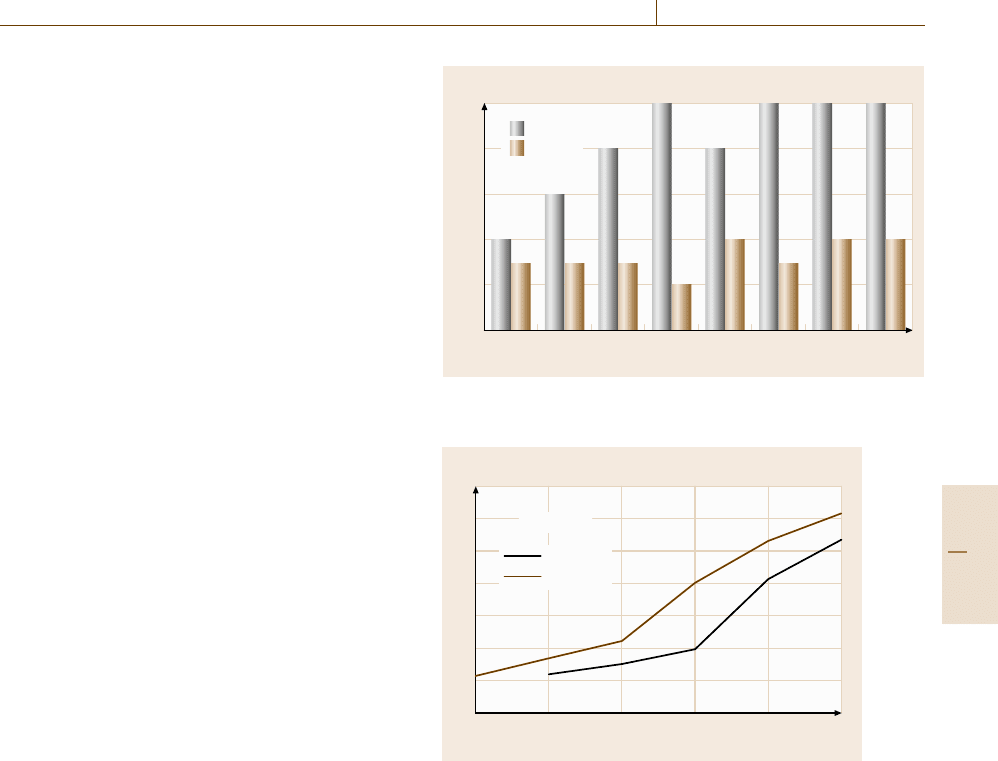
Material–Environment Interactions 15.1 Materials and the Environment 853
radiant exposure of about 3.5MJ/m
2
. With increasing
relative humidity and temperature, increasing degrada-
tion can be seen. In the temperature range 20–40
◦
C
a stronger increase of the dependence, which proba-
bly correlates with the change of the glass-transition
temperature, can be observed.
In contrast to Matsuda and Kurihara [15.33], who
observed a strong influence of moisture content on
changes of mechanical properties of PE-LD during
weathering, Löschau and Trubiroha [15.34] could not
confirm this result in the 1970s with three different PE-
LD samples. Investigations with different high-density
polyethylene (PE-HD) films however, showed a dis-
tinct influence of moisture on the changes of mechanical
properties, decrease of molecular mass and the forma-
tion of carbonyl groups. After UV radiant exposure of
13 MJ/m
2
in a Global UV-Test device at 40
◦
C and rel-
ative humidities of 20, 55 and 95%, the carbonyl index
increased from 0.6 at 20% RH to 2.5 at 95% RH;the
decrease of molar mass increased from 14% at 25% RH
to 23% at 95% RH.
From these results, one cannot conclude that the
photooxidation of PE-HD is dependent on moisture in
contrast to PE-LD. The PE-LD was a pure polymer
whilst PE-HD contained additives.
Other important parameters may be the type of wet-
ting, e.g. dew or rain, and the duration of the wetness
of the wet–dry cycles, which can cause mechanical
stresses during the absorption or desorption of water.
Photodegradation: Influence of Atmospheric Acid
Precipitation. Investigations on atmospheric precipita-
tion show that rain with a pH of 2.4–5.5, fog with a pH
of 2.2–4.0 and dew with a pH ≥ 2.0 are not rare phe-
nomena, and not only observed in industrial regions.
Acid atmospheric precipitation is formed when specific
pollutants combine with water or dust particles in the
atmosphere. By far the largest contribution to this prob-
lem arises from sulphur dioxide SO
2
, a by-product of
fossil-fuel combustion. In the atmosphere, SO
2
concen-
trations of up to 1 ppm are no rarity during the morning
rush hours with the increased use of heating systems.
When oxidized to sulphuric acid, H
2
SO
4
, it accounts
for 62–79% of the acidity of rain. Most of the remain-
ing acid is from nitrogen oxides NO
x
, found mainly in
automobile exhaust fumes, which are oxidized to nitric
acid HNO
3
(15–32%). In addition to these two main
species, hydrochloric acid HCl (2–16%), also produced
by burning coal, is found in the atmosphere [15.35].
However, rain, dew, fog and dust with pH ≥ 2.0 are
not the final forms of the acid precipitation which can
>12
12
6
3
1.5
0
12345678
Specimen No.
ΔE
10 % r.h.
90 % r.h.
Fig. 15.11 Weathering-induced discoloration ΔE of white poly-
vinylchloride at low and high relative humidity
70
60
50
40
30
20
10
0
01020304050
10 % r.h.
90 % r.h.
3.5 MJ/m
2
ΔM
V
(%)
T (°C)
Fig. 15.12 Photodegradation of polyamide 6 with temper-
ature and relative humidity after UV radiant exposure of
about 3.5MJ/m
2
,whereM
v
is the molar mass
act on surfaces of polymeric materials. Following the
vapor–pressure curves it can be stated that the acid pre-
cipitation will concentrate up to about 70% sulphuric
acid on hot and inert surfaces by the evaporation of
H
2
O, HNO
3
and HCl. A summary of the influence of
acid precipitation on different polymers has been pub-
lished [15.36, 37]. Hindered amine light stabilizers can
be another weak point of technical polymeric mater-
ials [15.38].
Results generally show a synergetic effect of acid
precipitations with UV radiation which accelerates the
effect of artificial weathering tests, but there are also
hints that the ageing processes of some polymers, e.g.
unstabilized PE and PC, can also be slowed down by
acid precipitations.
Part D 15.1
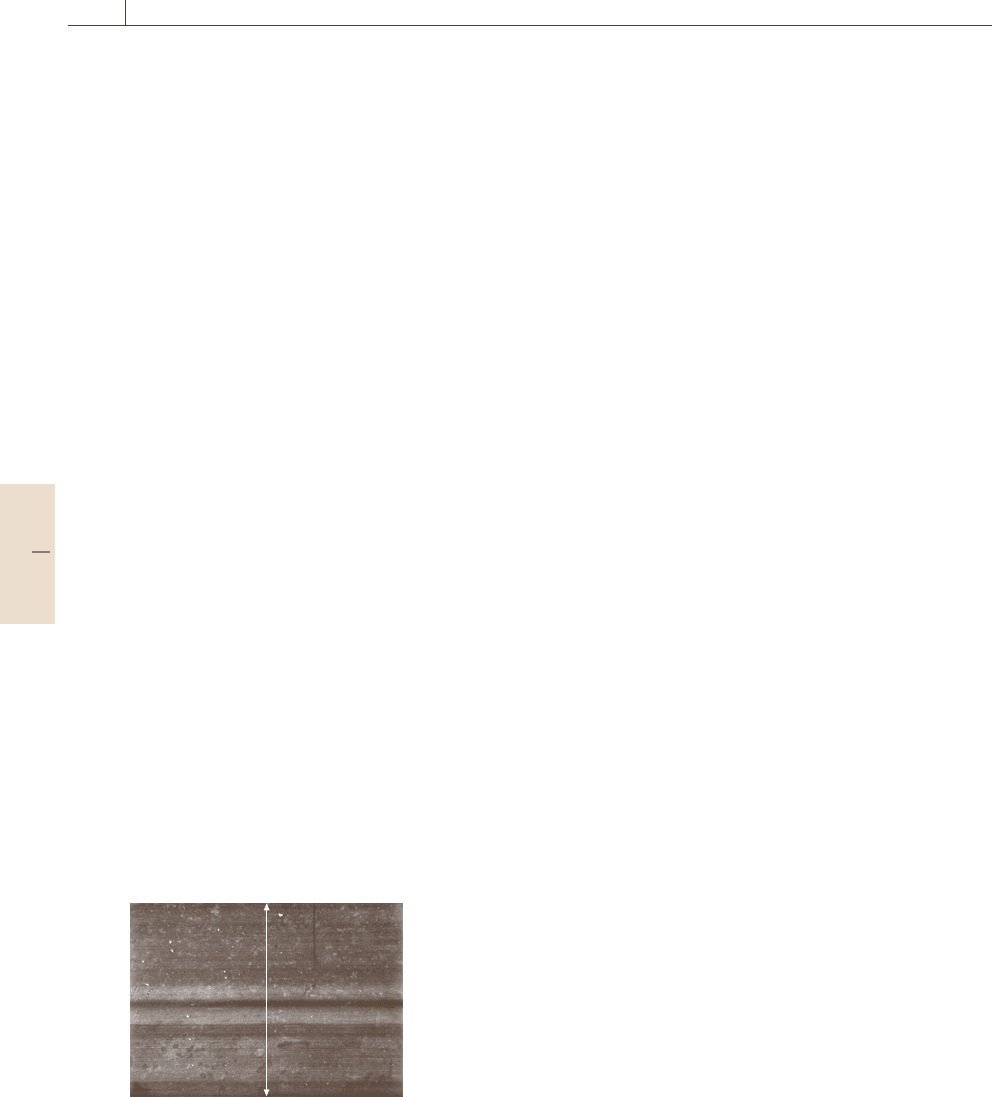
854 Part D Materials Performance Testing
Photodegradation: Influence of Biofilms. Any sur-
face of a material has a biofilm. This biomaterial or
products of their metabolism may also have a syner-
gistic effect on the weathering behavior of polymeric
materials, e.g. the mildew growth that causes pinholes
in automotive coatings, especially in warm and humid
climates like in South Florida. An attempt to produce
the formation of these pinholes by means of standard-
ized laboratory mildew tests that did not incorporate
radiation failed [15.39].
Dragonflies that confuse a glossy clear coat with
a water surface lay their eggs on this surface. Because of
heating by solar radiation and the photochemical action
of UV radiation, these eggs will be destroyed. Stevani
et al. have demonstrated that the degradation products
can hydrolyze acrylic/melamine resins that are in com-
mon use for clear coats [15.40].
Photodegradation: Influence of the Prior History
of Test Specimens. Menzel and Schlüter [15.21], see
above, described a decrease of weathering resistance
after repeated processing of PVC. Similar results were
obtained by Chakraborty and Scott for PE-LD [15.41].
This means that results from weathering, as well
as being influenced by climatic quantities, may also be
affected by the prior history of the exposed specimen
(surface), for example by the quality of the specimen
surface. Figure 15.13 demonstrates the influence of sur-
face roughness on the discoloration of a white specimen
of an extruded PVC window frame. By artificial irradi-
ation in a dry climate, dark brown stripes develop over
some areas, where the unexposed specimen showed
a reduced gloss from processing.
Drying conditions of a coating may influence its
ageing behaviour different loss of stabilizer. An increase
of the degree of crystallinity of polyamide by annealing
can increase its stability. Therefore, different prior his-
50 mm
Fig. 15.13 Effect of surface roughness on the discoloration
of a white polyvinylchloride specimen. Surface areas that
were originally glossy show a light color change, surface
areas that were dull show a strong dark brown color
tory of test specimens are often the cause of varying
weathering results.
Natural Weathering. In practice, many polymeric ma-
terials are exposed to the whole variety of climatic
conditions in the world. High levels of UV irradiance,
annual UV radiant exposure, temperature, and humid-
ity are extreme conditions for most polymeric materials.
However, depending on the anticipated market of the
polymer product, other exposure conditions may be im-
portant, e.g. maritime exposure to salt spray.
Corresponding to the variety of climates that are
a result of latitude, altitude, and special geographical
conditions, there are numerous natural-weathering sites
across the world.
Benchmark climates for natural-weathering tests are
the warm and humid, subtropical climate in Florida
and the hot and dry, desert climate in Arizona, see
Wypych [15.42].
At a given exposure site the real action of weather
conditions can be varied by different exposure angles
from the horizontal to vertical, by exposure under glass,
by sun-tracking exposure or by Fresnel solar concentra-
tors.
The following considerations have to be taken into
account
1. It is very difficult to really reproduce results from
an outdoor exposure in weathering devices, be-
cause the outdoor exposure results vary for different
locations, e.g. outdoor exposures at geographical lo-
cations such as Florida or Arizona, which accelerate
the ageing of polymers compared to Europe, do not
duplicate the ageing results of outdoor exposures
in Europe. Even at one geographical location, the
weather conditions of a season or a year, and there-
fore the ageing results, are not repeatable within
a manageable time.
2. Any accelerated test, either artificial or outdoor, is
only an approximation to the exposure stress in the
field.
Artificial Weathering. To estimate the service life of
products made from polymers or for the development
of more stable polymers, the conditions of outdoor ex-
posure are simulated in accelerated artificial-weathering
devices. These machines were introduced in 1918, but
a long period of time was required for the develop-
ment from the first purely artificial radiation sources
equipped with a carbon arc to artificial weathering de-
vices. In the course of time, these devices have become
Part D 15.1

Material–Environment Interactions 15.1 Materials and the Environment 855
good simulators of the actinic portion of the solar radia-
tion. This means that there may be a good simulation of
the first photophysical reaction of photochemical age-
ing in these machines. The other climatic quantities of
the weather can never be simulated perfectly due to time
compression or acceleration; for this reason, deviations
can influence the ageing result and affect the correlation
with results from outdoor exposures.
There are a number of different concepts for these
weathering devices
1. Devices equipped with xenon arc lamp(s). These
machines show good simulation of the maximum of
spectral irradiance in the UV and visible (Vis) range
of terrestrial solar radiation at vertical incidence of
direct solar radiation.
The main advantage of these devices is that even
very light-sensitive materials, i.e. sensitive to Vis ra-
diation, can be investigated. The main disadvantage
is the high thermal charge to the specimen surfaces
by Vis and IR radiation, which makes conditioning
of the surfaces at low temperatures and high relative
humidity during irradiation impossible.
2. Devices equipped with fluorescent UV lamps. These
machines show good simulation of the actinic por-
tion of terrestrial solar radiation with fluorescent
type 1 (340) UV lamps and a combination of dif-
ferent types of fluorescent UV lamps.
The big advantage of these devices is their low en-
ergy consumption and a very low thermal charge
to the specimen surfaces by Vis and IR radiation.
Therefore, irradiated surfaces of specimens can be
easily conditioned over wide temperature and rel-
ative humidity ranges. However, there are some
limitations concerning lightfastness tests of speci-
mens that are very sensitive to visible radiation.
3. Devices with carbon arc(s). These machines show
a spectral distribution of irradiance that differs
strongly from that of terrestrial solar radiation. Ad-
ditionally there is the same disadvantage as for
xenon-arc machines: a high thermal charge to the
specimen surfaces by Vis and IR radiation
These machines are mainly used in the Asian mar-
ket.
Weathering Standards. There are hundreds of national
and international standards and company specifications
that prescribe exposure conditions for artificial and out-
door weathering exposure tests considering usual and
specific conditions, e.g. in the automotive industry or
for roofing materials.
Most of these tests procedures are based on the fol-
lowing International Organization for Standardization
(ISO) standards
•
for the natural exposure of plastics: ISO 877 Plas-
tics – methods of exposure to solar radiation (Part 1:
General guidance, Part 2: Direct weathering and
weathering using glass-filtered solar radiation, Part 3:
Intensified weathering using Fresnel mirrors);
•
for paints and varnishes: ISO 2810 Paints and var-
nishes – natural weathering of coatings – exposure
assessment.
•
artificial exposure procedures are described for plas-
tics in: ISO 4892 Plastics – methods of exposure to
laboratory light sources, parts:
a) general guidance,
b) xenon-arc sources,
c) fluorescent UV lamps,
d) open-flame carbon-arc lamps,
•
and for paints and varnishes in: ISO 11341 Paints
and varnishes – artificial weathering of coatings and
exposure of coatings to artificial radiation alone –
exposure to filtered xenon-arc radiation (09.94); and
ISO 11507 Paints and varnishes – exposure of coat-
ings to artificial weathering – exposure to fluorescent
UV and water.
Some failures of polymeric materials from out-
door exposure may not be able to be reproduced in
artificial-weathering devices using standard weathering
conditions. In these cases, it may be necessary to deviate
from the standard conditions.
Determination of Property Changes. Before a property
change due to environmental impact can be detected,
it is of the outmost importance to characterize the ma-
terial to be exposed as thoroughly as possible in the
unexposed state. It has to be taken into account that
the production process of the material might already
have resulted in a heterogeneous material in regard to
its properties on the surface compared to the bulk.
In most cases, an environmental impact on a ma-
terial first affects its surface before it accumulates and
spreads over the bulk of the material. This brings up two
consequences for the determination of property changes:
especially in the early stages of an environmental im-
pact a heterogeneous distribution of property changes
between the surface and bulk will result [15.43]and
secondly, the first effects of weathering will be able
to be detected by surface-emphasizing detection tech-
niques.
Part D 15.1

856 Part D Materials Performance Testing
Generally, weathering-induced degradation will start
on a molecular level. For instance impurities in the ma-
terial or external contamination with highly reactive
secondary molecules can cause an increased reactivity
in this region and act as the starting point of the degra-
dation process, which can then spread like an infection
until ultimately the whole bulk of the material is af-
fected by the degradation process [15.43]. This means
that detection techniques for weathering effects that are
able to detect changes on a molecular level have the
potential to detect the earliest stages of a degradation
process.
Guidance for the determination of property changes
of general interest is given for plastics by ISO 4582
(Plastics – determination of changes in color and varia-
Table 15.2 Common test procedures for property changes due to environmental impact on plastics, paints and varnishes
Property category Individual property assessed Standard
General Mass
Dimension
Appearance Gloss retention ISO 2813
Light transmission ISO 13468-1
Haze ISO 14782
Blistering ISO 4628-2
Cracking ISO 4628-4
Flaking ISO 4628-5
Chalking ISO 4628-6 (tape method)
ISO 4628-7 (velvet method)
Corrosion around a scribe ISO 4628-8
Filiform corrosion ISO 4628-10
Cracking or crazing
Delamination
Warping
Colorimetry, for instance yellowing SO 7724-1
Biofilm formation
Migration of components from inside to surface
Mechanics Tension (particular elongation at break) ISO 527, all parts
Flexibility ISO 178
Impact strength
Charpy impact strength ISO 179-1, ISO 179-2
Izod impact strength ISO 180
Puncture test ISO 6603-1, ISO 6603-2
Tensile impact strength ISO 8256
Vicat softening temperature ISO 306
Temperature at deflection under load ISO 75, parts 1–3
Dynamic mechanical thermal analysis ISO 6721, parts 1, 3, and 5
Chemistry Effect of immersion of sample in chemicals ISO 175
Chemical changes (such as the detection of
oxidation products by infrared spectroscopy)
tions in properties after exposure to daylight under glass,
natural weathering or laboratory light sources) and for
paints and varnishes by ISO 4628 (Paints and varnishes
– evaluation of degradation of coatings; designation of
quantity and size of defects, and of intensity of uniform
changes in appearance), Parts 1–10.
A number of detailed techniques for the investigation
of individual property changes are described in separate
standards. Common testing procedures of effects of en-
vironmental impacts and – as far as they exist – their
respective standards can be found in Table 15.2.
A review of the analytical techniques to look for
the reasons for the observed changes can be found in
Kämpf [15.44] and other references [15.45–49]. A num-
ber of these techniques are listed in the following.
Part D 15.1

Material–Environment Interactions 15.1 Materials and the Environment 857
Table 15.3 Analytical techniques that can be used for spot and surface analysis (see also Sect. 6.1, surface chemical
analysis)
Acronym Meaning Principle/assessed property Resolution References
EMA Electron
beam
micro-
analysis
Excitation by electrons, emission of x-ray photons for elements
boron to uranium.
Applications: detection of inorganic inhomogeneities in poly-
meric materials
Lateral:
0.1–3μm
(minimum
13 nm)
[15.50]
SEM +
EDX
Scanning
electron mi-
croscopy
coupled
to energy
dispersive
analysis
As above, but energy dispersive analysis instead of focusing
wavelength dispersive analysis.
For light elements slightly inferior spectral resolution and
lower sensitivity than EMA
Lateral: 1 μm,
Depth: ≈1 μm
[15.51,52]
TEM Transmission
electron
microscopy
Scattered and unscattered electrons are detected after excita-
tion with electrons. In crystalline regions electron diffraction
occurs
Lateral:
0.2–10μm
[15.53]
LAMMA Laser
microprobe
mass
analysis
Excitation by photons. Laser light is focussed through a light
microscope onto the sample, which is caused to evaporate.
Emitted ions are detected in time-of-flight mass spectrometer.
Detection limit better than 10
−18
–10
−20
g or concentrations in
ppb range
Lateral: better
than 1 μm
Depth: > 0.1 μm
[15.54,55]
ESCA
(XPS)
Electron
spectros-
copy
for
chemical
analysis
(x-ray pho-
toelectron
spec-
troscopy)
Photoionization of electrons on inner atomic shells by charac-
teristic x-ray irradiation.
Quantitative identification of atoms, determination of bonding
state, oxidation states, depth profiling, identification of poly-
mers.
Detection of inorganic or polymeric impurities on polymer
matrix. Crude depth profiling possible by angle-resolved XPS
(control of analyzer collection angle)
Lateral:
1–1000 μm.
Imaging: e.g.
0.1–10mm
Depth: 1–10 nm
[15.56,57]
AES Auger
electron
spectros-
copy
Emission of secondary electrons after excitation with x-ray. In
combination with ablation by sputtering allows depth profiling
Lateral:
0.1–3μm
Depth:
0.4–2.5nm
[15.58]
(TOF-)
SIMS
(Time-of-
flight)
secondary
ion mass
spectrometry
Surface is sputtered with positively charged ions. Emitted par-
ticles are neutral as well as secondary ions; the latter are
detected by means of mass spectrometry
Trace detection of polymers, composition of copolymers and
polymer blends, detection of additives or contamination on
polymer surfaces, determination of molecular mass
Lateral: < 50 μm,
(imaging SIMS:
200 nm),
Depth: 1 nm
[15.59,60]
XFA X-ray
fluorescence
analysis
Excitation by photons, emission of photons. Applicable for
trace detection of impurities at 10
10
–10
13
atoms/cm
2
Lateral: 1 μm [15.61]
ATR -IR Attenuated
reflection
infrared
spec-
troscopy
Absorption spectroscopy with infrared radiation source. Sam-
ple is characterized using multiply attenuated reflection of IR
between sample surface and totally reflecting crystal on top.
Vibrational spectra allow qualitative and quantitative analysis
of functional groups and render information on the constitu-
tion. Carbonyl bands can give measure for oxidative ageing
Lateral: ≈3mm [15.62]
Micro-
IR
Micro-
infrared
spectro-
metry
Coupling of infrared spectrometer to microscope Lateral: 1 μm [15.63]
AFM Atomic
force
microscopy
The force between the tip and the surface of the sample is
monitored while scanning over it
Depth: 0.5nm [15.64]
LM Light
microscopy
Photons of visible light transmitted through, or reflected from,
the sample material are depicted
Lateral: ≈1 μm [15.65]
Part D 15.1
